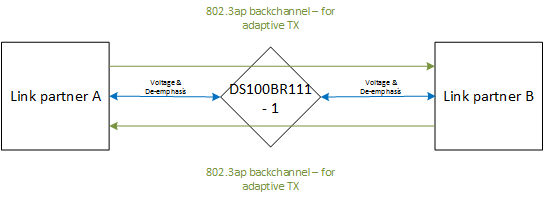Other Parts Discussed in Thread: DS125BR111
The description of this device has this statement:
“When configured as a 10G-KR repeater, the DS100BR111 allows the KR host and the end point to optimize the full link by adjusting transmit and receive equalizer coefficients using back-channel communication techniques specified by the 802.3ap Ethernet standard.”
I want to confirm, when the link is configuring the transmit strength and receive equalization for the endpoints of the link, is the DS100BR111 functioning as a part of this process?
Please see the diagram below:
When the endpoints are configuring their transmit and receive equalizer coefficients, will the DS100BR111 also monitor the link and modify its equalizer coefficients as seen in the first possibility identified in the diagram above.
For example, say Endpoint B says that it requires a higher transmit from the link, will DS100 b increase its transmit strength from this request, or will that request propagate down to Endpoint A and Endpoint A will increase its transmit coefficients (conceptually seen as the second possibility identified in the diagram above - as if the repeaters were not present)?


